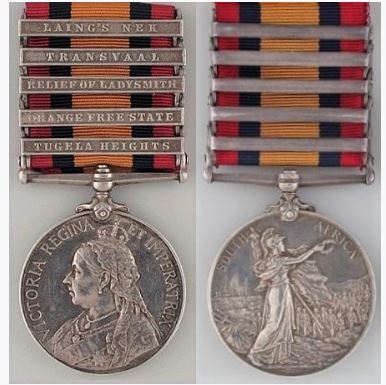Queens South Africa Medal
From Our Contribution
 Obverse and reverse of the Medal with Clasps | |
Eligibility
A British campaign medal instituted in 1900 and awarded to British and Empire personnel who served in the Second Boer War between 11 Oct 1899 and 31 May 1902. Approximately 178,000 medals were awarded with a total of 26 clasps indicating participation in actions and campaigns. No individual could receive more than nine. Given the expected short duration of the war, early medals were minted with either 1900 or 1901 on them, but when the war stretched into a second and then third year, the medals were issued without dates.
The clasps fell into three groups: Battle, State and Dates. Battle clasps were awarded for participation in a specific action or campaigns, although recipients could not receive both DEFENCE and RELIEF clasps for Mafeking, Kimberley or Ladysmith. State clasps were for service in a state where no battle clasps were a specific action, but Cape Colony and Natal could not be both awarded. The two date clasps, normally worn on the Kings medal could be worn on the Queens medal if the individual did not qualify for the Kings Medal (18 months service or more between the above dates.) Clasps, in order of wearing:
- Cape Colony (11 Oct 1899 - 31 May 1902)
- Natal (11 Oct 1899 - 11 Jun 1900)
- Rhodesia (11 Oct 1899 - 25 May 1900)
- Relief of Mafeking (1 Oct 1899 - 17 May 1900)
- Defence of Kimberley (14 Oct 1899 - 15 Feb 1900)
- Talana (20 Oct 1899)
- Elandslaagte (21 Oct 1899)
- Defence of Ladysmith (3 Nov 1899 - 28 Feb 1900)
- Belmont (23 Nov 1899)
- Modder River (28 Nov 1899)
- Tugela Heights (14 - 17 Feb 1900)
- Relief of Kimberley (15 Feb 1900)
- Paardeberg (17 - 26 Feb 1900)
- Orange Free State (28 Feb 1900 - 31 May 1902)
- Relief of Ladysmith (15 Dec 1899 - 28 Feb 1900)
- Driefontein (10 Mar 1900)
- Wepner (9-25 Apr 1900)
- Defence of Mafeking (13 Oct 1899 - 17 May 1900)
- Transvaal (24 May 1900 - 31 May 1902)
- Johannesburg (29 May 1900)
- Laing's Neck (2 - 9 Jun 1900)
- Diamond Hill (11 - 12 Jun 1900)
- Wittebergen (1 - 29 Jul 1900)
- Belfast (26 - 27 Aug 1900)
- South Africa 1901 (1 Jan - 31 Dec 1901)
- South Africa 1902 (1 Jan - 31 May 1902)
Description
The Queen's South Africa Medal is a silver or bronze disk, 38 mm (1.5 inches) in diameter. The bronze medal was awarded to non-combatant Indian troops and other non-combatant men of whatever nationality who drew military pay, although some silver medals were awarded to native troops. The suspender is attached to the medal with a claw mount and a pin through the upper edge of the medal.
Obverse The obverse shows a crowned and veiled effigy of Queen Victoria, facing left, with the legend "VICTORIA REGINA ET IMPERATRIX" around the upper perimeter.
Reverse The reverse, shows Britannia holding the Union Flag in her left hand and a laurel wreath in her right hand. In the right background are troops marching inland from the coast. In the left background are two men-of-war, with Neptune's Trident and Britannia's shield on the ground in the foreground. Around the top perimeter are the words "SOUTH AFRICA".